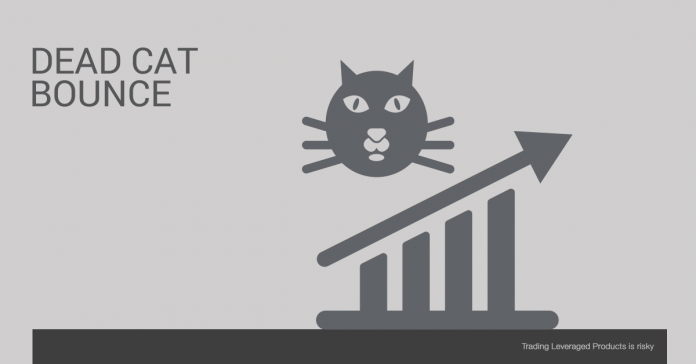Dead cat Bounce! A new term? Not really but definitely something that we haven’t seen for more than a generation.
In general, investors throughout the years invented this term as a follow up to a market free fall. By definition, the “Dead cat Bounce” is simply a market phenomenon that translates into temporary small and short-lived rebounds of an asset’s price within a prolonged period of downside. This term is based on the idiom that “even a dead cat will bounce if it falls far enough and fast enough“. Hence in the financial market it is said that even if an asset falls with a considerable speed, it would rebound as even a dead cat would bounce. However, every time there is a rebound, the overall initial trend is then anticipated to resume, bringing the bearish influence back into play.
In addition, the phenomenon can occur in any market, yet is particularly prevalent in equity markets. It is often the case that it is considered a continuation pattern.
Why are we raising this topic now? This March, was the first time after Black Monday 1987 that we have seen the worst intraday selloffs in stock markets. Since February 20th, the stock market entered an aggressive bear market with a few days of an absolute rally. An example was the 13th of March in which the stock market roared back in the biggest one-day rally since 2008 after its worst single-day crash in 33 years just a day before. This is the classic dead cat bounce.
If you closely observe stock market behaviour in March you will notice that there is a dramatic decline, with a number of days when the market reversed some of its losses, but failed to take the bait, and eventually fell back down again. This is a situation of portfolio managers wanting to sell some of their positions and when they see some strength in the market, decided to unload. This is what we call a “dead cat bounce” after it falls from high enough. Remember however that not every correction/reversal can be interpreted as a dead cat bounce.
Theoretically this term is defined as the term in which,
- A stock in a severe steep decline has a sharp bounce off the lows.
- A small upward price movement in a bear market after which the market continues to fall.
Click here to access the HotForex Economic Calendar
Andria Pichidi
Market Analyst
Disclaimer: This material is provided as a general marketing communication for information purposes only and does not constitute an independent investment research. Nothing in this communication contains, or should be considered as containing, an investment advice or an investment recommendation or a solicitation for the purpose of buying or selling of any financial instrument. All information provided is gathered from reputable sources and any information containing an indication of past performance is not a guarantee or reliable indicator of future performance. Users acknowledge that any investment in Leveraged Products is characterized by a certain degree of uncertainty and that any investment of this nature involves a high level of risk for which the users are solely responsible and liable. We assume no liability for any loss arising from any investment made based on the information provided in this communication. This communication must not be reproduced or further distributed without our prior written permission.























